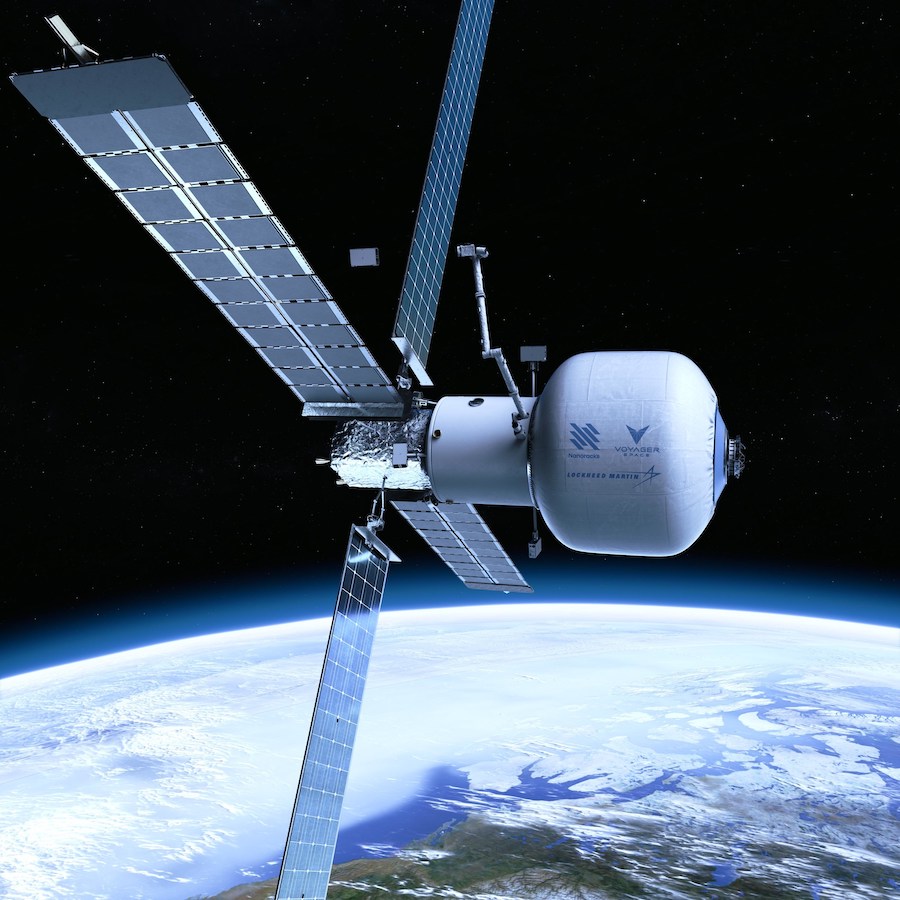Space News & Blog Articles
Nanoracks announces plans for commercial space station
 Artist’s concept of the Starlab space station. Credit: Nanoracks
Artist’s concept of the Starlab space station. Credit: Nanoracks
Nanoracks announced Oct. 21 it is teaming with Lockheed Martin to develop a commercial crewed space station named Starlab that officials said could reach initial operational capability by 2027.
The commercial space lab will be continuously crewed to conduct critical research, support off-planet industrial activity, and ensure continued U.S. presence in low Earth orbit after the retirement of the International Space Station, Nanoracks said in a press release.
Nanoracks launched a commercial airlock module to the International Space Station in December 2020 aboard a SpaceX cargo mission. The airlock is designed to transfer experiments and small satellites between the pressurized interior of the space station and the vacuum of space.
The company also arranges accommodations for commercial experiments at the space station, and rides for small CubeSats to be deployed into orbit.
“Since the beginning, Nanoracks has sought to own and operate a private space station to fully unlock market demand,” said Jeff Manber, CEO and co-founder of Nanoracks, in a statement. “Our team has spent the last decade learning the business of space stations, understanding customer needs, charting market growth, and self-investing in private hardware on the ISS like the Bishop Airlock. Nanoracks and our team are excited to work with NASA and our friends across the world as we move forward with Starlab.”
Lockheed Martin will design and build Starlab’s large inflatable habitat. The station will also include a metallic docking node, a power and propulsion element, and a large robotic arm for servicing cargo and payloads, according to Nanoracks.
The station will continuously host up to four astronauts, supporting scientific experiments and in-space manufacturing capabilities, Nanoracks said.
“Nanoracks’ Starlab business model is designed to enable science, research, and manufacturing for global customers, and bring added value to long-duration sovereign astronaut missions,” the company said. “Starlab will also serve tourism and other commercial and business activities.”
Voyager Space, the majority shareholder of Nanoracks, will lead strategy and investment for the Starlab program. Nanoracks did not disclose the expected cost of the space station, or its plans for funding the venture.
“We’re excited to be part of such an innovative and capable team — one that allows each company to leverage their core strengths,” said Lisa Callahan, vice president and general manager of commercial and civil space at Lockheed Martin. “Lockheed Martin’s extensive experience in building complex spacecraft and systems, coupled with Nanoracks’ commercial business innovation and Voyager’s financial expertise allows our team to create a customer-focused space station that will fuel our future vision.
“We have invested significantly in habitat technology which enables us to propose a cost-effective, mission-driven spacecraft design for Starlab,” Callahan said in a statement.
Nanoracks, a Houston-based company, leads one of several teams developing concepts for commercial space stations.
Axiom Space, another company headquartered in Houston, won an award from NASA in 2020 to attach a commercial pressurized module to the International Space Station.
Axiom says their first ISS module is scheduled for launch in 2024, but it is just the first of several elements Axiom plans to attach to to the international research complex. Under Axiom’s roadmap, the modules will eventually detach from the ISS to form a privately-owned space station.
Sierra Space, a subsidiary of Sierra Nevada Corp., has also revealed its concept for a commercial space station in low Earth orbit.
The companies are vying for NASA support in a public-private partnership to develop a commercial replacement for the International Space Station.
NASA’s Commercial Low Earth Orbit Destination, or CLD, program aims to help U.S. industry develop commercial habitats where NASA astronauts, foreign space fliers, and private astronauts could visit, live, and work after retirement of the ISS.
NASA hopes to keep the International Space Station operating until at least 2030, but eventually wants to transition responsibility for low Earth orbit stations to the private sector. Agency officials say that will allow NASA to focus its resources on deep space exploration.
This email address is being protected from spambots. You need JavaScript enabled to view it. the author.
Follow Stephen Clark on Twitter: @StephenClark1.
When you subscribe to the SpaceZE News Feed, we will send you an e-mail when there are new updates on the site so you wouldn't miss them.

